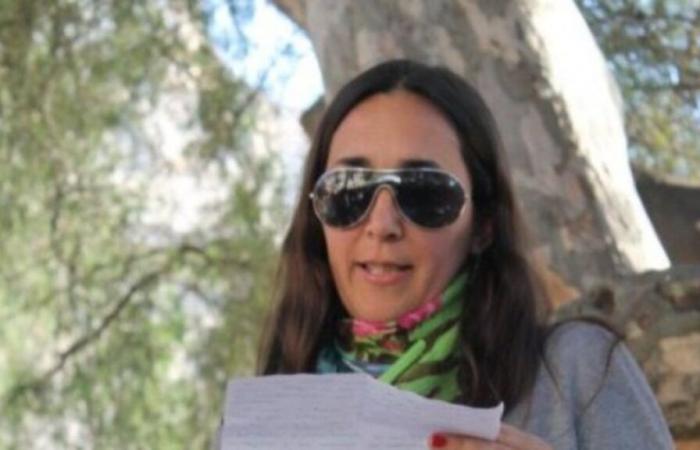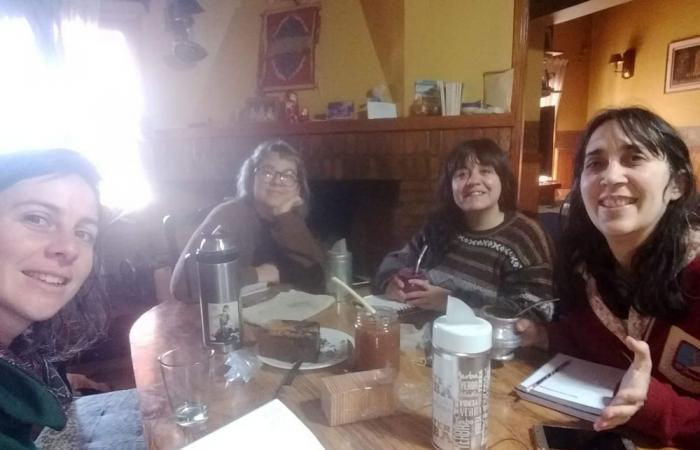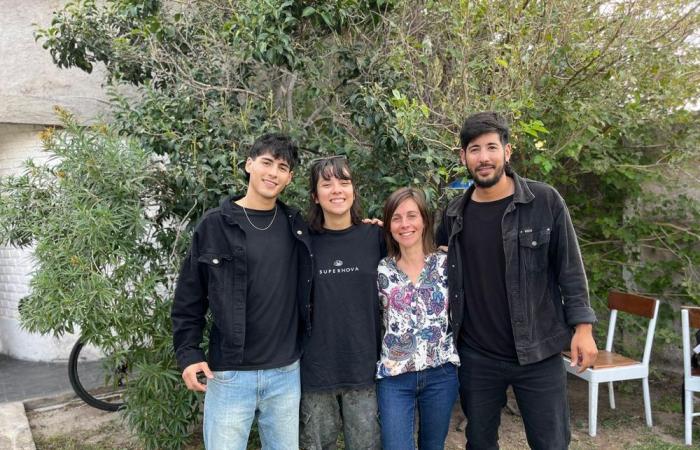“Paula always linked her militancy to education. For her, talking about memory was also talking about citizenship, love and rights,” Muñoz recalls.
The first films were made in Paula’s house in Tunuyán and in other significant spaces of his life. In addition to its testimony, the project includes interviews with family members, friends, human rights militants and local referents. Historical material was also recorded that contextualizes its life in the dark years of the dictatorship and in democratic reconstruction.
With an initial structure designed as a documentary series of four or five chapters, Paula’s story began to take shape.
Paula Molinas
Organizational meeting towards the production of the documentary, Paula Molinas with its filmmakers.
A necessary pause
Paula’s sudden disease and subsequent death stopped the advance of the documentary. The duel, the pain and respect for the emotional times of those who boosted the project led to suspend the recordings. “There was a lot of emotional movement. We had to give us time to elaborate, to take care of the process,” Muñoz explains.
The material, however, was protected: hours of recordings, interviews, historical records and planning that expected the appropriate time to be retaken.
The impulse of memory
That moment came this year. The publication of a note from the Andes that reviewed Paula’s life within the framework of March 24, revived the commitment of the realization team. “when we read the note we feel it was a signal. It was time to finish what we had started,” says Muñoz. Thus, in April, after several meetings and conversations with Paula’s family, they decided to resume the project.
Today, Mariela Muñoz and Pilar Tula – both members of the inks – coordinate the work. With the support of the Producer Supernova (from San Luis) and the Molinas family, the team began to reorganize the filming that remain in Mendoza, Córdoba and Santa Fe.
David López, Pilar Tula, Mariela Muñoz and Exequiel López..jpeg

Documentary filmmakers “El Rocabeza de Paula”, David López, Pilar Tula, Mariela Muñoz and Exequiel López.
Solidarity collection and new format
To be able to make filming and the edition of the material, Mariela and Pilar launched a solidarity collection under the name of the project: “Paula’s puzzle”. The documentary will maintain its short serial format, with chapters between 15 and 20 minutes, designed as pedagogical resources to be worked on schools and educational spaces.
In addition, part of the material will include animation segments that will accompany Paula’s stories, contributing new dimensions to its history.
Through a bank account and Instagram (@Romabezasdaula)invite those who wish to join this collective memory construction to collaborate. “Building the documentary collectively is also a way of honoring Paula. She believed in links, in human networks, in the power to do together,” says Muñoz.
Currently, the project is in 40% advance, with weekly production meetings, shooting planning and support collection to make trips possible. “In a time of so much social uncertainty, betting on the collective is a challenge and a necessity. It is the way we know how to continue sowing memory,” Muñoz concluded.
Who was Paula Molinas?
Born in 1974, daughter of Montoneros militants, she was a degree in letters, teacher, militant of social causes, mediator of the fair, mother and companion. Tunuyanina by adoptionCordoba for causalities and SantaFecina by birth.
Already in years of state terrorism, her mother, María Guadalupe Porporate, a social work student, died in September of that year after the explosion of a bomb, when Paula was barely six months. His father, Francisco “Pancho” Molinas, tried to take care of her in hiding, but the difficulties forced him to leave her to the shelter of an aunt.
Later, already in Buenos Aires and with a new companion, Clara, Paula’s raising continued until Francisco was killed. Clear, marked and persecuted, he managed to hide with Paula, but the threat persisted. Before being kidnapped and missing, the latter left the girl to the care of trusted friends.
Thus began another stage for Paula, who was raised with another identity and under the name of “Pipa”, as a survival strategy in those times of terror. As a child, he knew some truths in a fragmentary way. During his childhood, which always had it in the happiest memories, he received explanations that did not finish closing. At 14, the questions were asked insistent. And at 19, he undertook the search for his origin.
A badly written fact in his last name, Molinas, with “s”, He complicated the trail, but a series of calls to telephone guide numbers finally took her to her biological family in Santa Fe. The biological family, had raised another girl, also called Paula, also born the same day, but that was not her true granddaughter. Both had been victims of errors in an era where identities seemed to be a privilege.
When time passed, DNA studies were conducted in Grandmothers of Plaza de Mayo, Paula was able to confirm its origin and restore its identity. Years later, in 2015, a new footprint arrived when the Argentine Forensic Anthropology team identified the remains of his father “Pancho”, buried as NN in a common grave.
Paula Molinas recognized in his adoptive family a part of his history. “They saved my life. They made mistakes, but they always told me the truth. They accompanied me when I decided to look.” And he also embraced his biological origin: “It is as if the river returned to its channel,” he used to say. To tell her story was for her a way of healing, to pay tribute to her parents, to bring them back every March 24 and, above all, to build memory for all.








